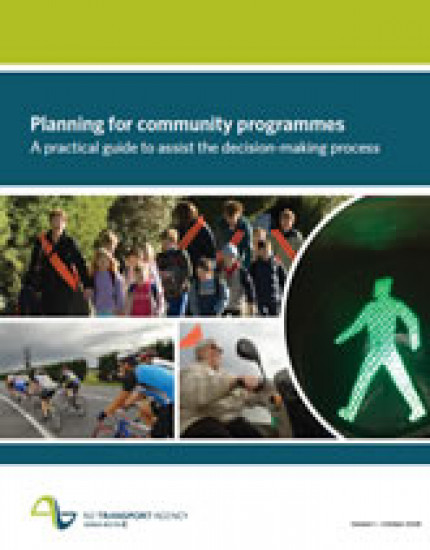A practical guide to assist the decision-making process in planning for community programmes.
Note: The Demand Management Community Programmes Activity class is currently under review, new guidance will be available in early in 2010.

Decisions about safe and sustainable land transport community programmes must be made in the context of the overall objective of an affordable, integrated, safe, responsive and sustainable land transport system. Each community programme and the resources being considered should be assessed for its contribution to the relevant strategic plans, sustainability targets identified in the New Zealand transport strategy 2008 and the Government policy statement on land transport funding 2009/10–2018/19, the New Zealand Energy Strategy and the New Zealand Energy Efficiency and Conservation Strategy, the Road safety to 2010 strategy and any other relevant policies or targets.
While all community programmes contribute to achieving transport targets, successful implementation of community programmes is significant. Targets from the New Zealand transport strategy most likely to be impacted by community programmes include:
Relevant targets in the New Zealand Energy Efficiency and Conservation Strategy include:
The Government policy statement on land transport funding details the government's desired outcomes and funding priorities for the land transport sector. The document has translated the long-term targets from the New Zealand transport strategy into short to medium-term targets, generally with a target date of 2015. Relevant targets include:
As well as national targets, it will be important to consider targets set at regional and local levels.
Travel behaviour change arising out of the implementation of community programmes has a positive impact on a number of other cross-government strategies. These include strategies promoted by the Ministry of Education, Ministry of Health, and Sport and Recreation New Zealand (SPARC).
Transport sector community programmes form an important part of the local, national and international focus on sustainable environments. These activities also bring benefits in terms of community well-being, engagement and development.
Community programmes promote community development by:
An essential part of community programmes is the opportunity they provide for ongoing understanding and improvement – building local capability, empowering communities on land transport system matters and adding a wider sense of community development. This includes achieving sustainable change in attitudes and behaviour at the community level and the sharing of information (success and good practice) among communities.
This guide will help approved organisations prepare road safety action plans. The decision-making process outlined in this guide will promote the development of road safety action plans that will link strategy to action, ensure decisions are informed by an evidence base and integrate decisions about managing infrastructure assets with services that infl uence how people use the land transport system. While the road safety action plan process should underpin requests for financial assistance for community programmes aimed at mitigating road safety risks, activities aimed at promoting more sustainable transport options could be developed using a similar planning and prioritisation process.
Packages should be composed of interconnected and coordinated activities. This may involve different organisations and different types of activities. The development and implementation of packages allows for the realisation of additional benefits from cumulative impacts and the opportunity for synergies between activities. Community programmes are particularly well suited to the development of packages.
This guide has been prepared to assist and prompt analysis between identified land transport system issues and the activities available to address them. While the guide provides some possible questions to prompt thinking and tables populated with initial information, it is intended that it be used as a starting point and initial template. The possible questions and content of the tables should be deleted from and added to as appropriate.
Page created: 13 November 2008